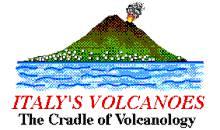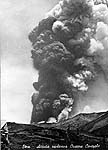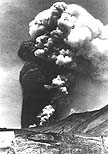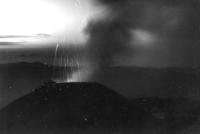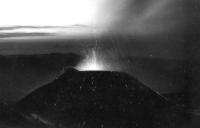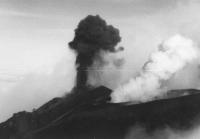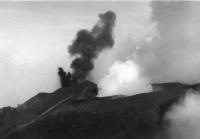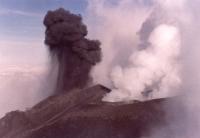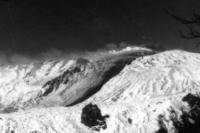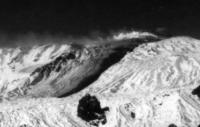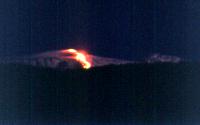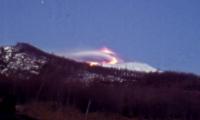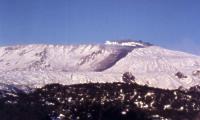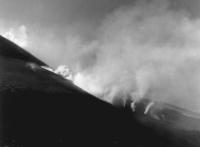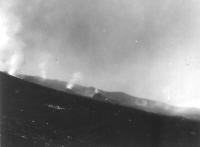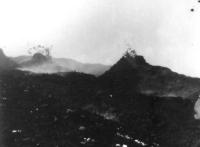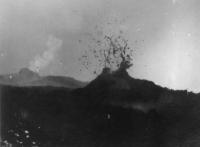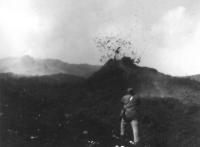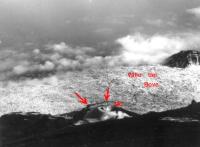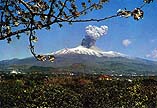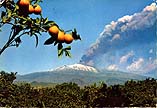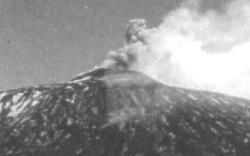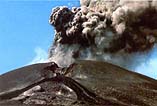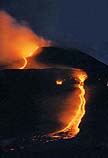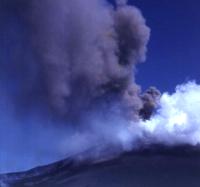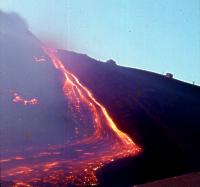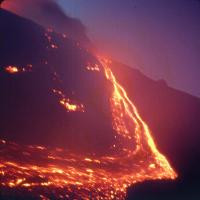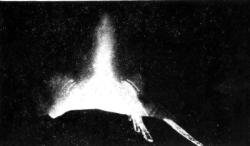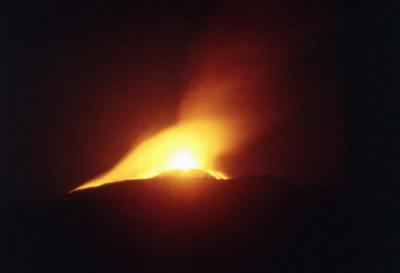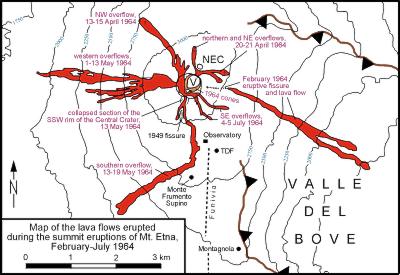| Etna
index |
||
| Geology | Geological history | Cones and craters |
| Eruptive characteristics | Eruptions before 1971 | Eruptions since 1971 |
| Etna and Man | References | Web sites |
| Weather forecasts | FAQ | Latest news |
The
1955-1971 summit eruptions, Part 2
1960-1964:
Paroxysmal eruptions from the Central Crater
A powerful explosive eruption occurred at the Central Crater
at about 11:30 h on 17 July 1960. Clear weather allowed a perfect view
of a spectacular eruption column rising majestically into the sky; informations
about the height of the column vary between 5 and 10 km. To tens of thousands
of people, both residents of the Etna area and visiting tourists, the
eruption was a marvelous natural spectacle, while in areas higher up on
the mountain flanks considerable damage to agricultural land was caused
by heavy tephra falls. Some forest fires were lit by incandescent pyroclastics
to a distance of 7 km from the summit, at an elevation of 1700-1800 m.
The sector most affected was on the NE side of the volcano, in the Linguaglossa-Fiumefreddo
area where scoriaceous lapilli with diameters of up to 5 cm were deposited
in a continuous sheet. On the main summit cone the thickness of the pyroclastic
deposit was about 10 m (Cucuzza Silvestri, 1960). The source vent of the
17 July 1960 paroxysm was the Voragine in the NE part of the Central Crater,
which had shown little activity since 1955. It was noted that at the time
of the paroxysm all activity at the NE Crater had ceased completely, a
fact that was repeated on numerous occasions in the following years. The
volume of pyroclastics produced by the paroxysm was estimated at 10 x
106 m3.
Little eruptive activity (except a few ash emissions from the NE Crater) occurred during the following three days, but on the evening of 20 July, the Voragine became active again to produce another spectacular paroxysmal episode with lava fountains up to 500 m high and a tall eruption column that rose to several km above the summit. The main paroxysmal phase, which occurred around 19:00 h, caused ash falls on the SE flank of the volcano (including the towns of Zafferana and Acireale, and arriving in the outskirts of Catania) and was followed by intermittent, very violent explosions. At about 22:00 h the activity showed a marked decrease, and for the next days, the only activity in the summit area consisted of sporadic weak ash emissions from the NE Crater.
In contrast to the 17 July 1960 eruptive episode, no volume data were made available after that of 20 July, but Cucuzza Silvestri (1960) noted that in terms of intensity the latter one was much smaller than the first one.
Investigations of the Central Crater made by volcanologists from Catania
during the quiet interval of late July revealed that after the two paroxysmal
episodes of 17 and 20 July the diameter of the Voragine had increased
to 250 m, and a wall of scoriae about 15 m high had built on its rim.
On 22 July, the level of active magma stood about 80 m below the rim,
and occasional explosions ejected incandescent fragments above the rim
of the Voragine. During the last days of July the activity increased again
both at the Voragine and at the NE Crater and continued at moderate levels
through early August. On 4 August the activity at the Voragine increased
notably, and on the evening of the next day, another paroxysmal eruptive
episode occurred from this vent. This episode began at 21:30 h and lasted
3 hours, and was characterized by lava fountains up to 1000 high, and
an eruption column rose several km above the summit. Ash fell to the ENE,
in the area of Fornazzo, Mascali and Piedimonte Etneo, and as far as the
coast. The eruptive episode ended with powerful loud detonations and emission
of ash.
With this spectacular eruptive manifestation the activity at the Central Crater came to an end - the crater remained relatively quiet until May 1961 - but only three days after its latest paroxysm , on the afternoon of 8 August, the NE Crater produced a series of loud explosions that shook windows in nearby villages. Similar activity occurred on 1 November, but only on 24 December 1960 did a new period of persistent activity begin, which culminated on 30 December with the emission of a lava flow from a new effusive vent in the saddle between the NE Crater and the main summit cone. From then on until mid-May 1961 the activity at the NE Crater was essentially continuous, with Strombolian explosions accompanied by the quiet outflow of lava from vents on the flanks or at the base of the pyroclastic cone of the NE Crater.
On 11-12 May 1961 a spectacular episode of paroxysmal activity occurred
within the Central Crater (probably from the Voragine) producing lava
flows that surrounded the NE Crater cone and then advanced towards NE
and NW, reaching lengths of 1.5 and 2.5 km, respectively. The longer,
northwestern flow advanced towards the Punta Lucia. Spectacular explosive
activity accompanied the emission of these lavas; it is notable that at
the same time the NE Crater remained active. Activity in the Central Crater
ended after one day, but continued at the NE Crater, which continued its
persistent activity for the next almost three years, until January 1964.
During the period from June 1961 until January 1964, the NE Crater produced a significant volume of lava which accumulated around the base of the cone, and attained a volume of more than 100 x 106 m3, assuming an effusion rate of close to 1 m3 per second. On several occasions lava flows extended several kilometers from the crater, especially in April and June 1963 when the flow fronts advanced in the direction of Piano Provenzana, threatening its scenic pine forests. This long period of relatively mild and regular activity was interrupted repeatedly by brief explosive events at the Central Crater, such as on 8-10 and 28 January, 21 February, 24 April, 29 July, early August and 21 December 1962. The main site of activity within the Central Crater was the Voragine.
In late January 1964 the activity at the NE Crater underwent a notable reduction and ended sometime before the 31st; heralding the beginning of the most dramatic eruptive sequence from the Central Crater in many decades.
Sometime during the night of 31 January-1 February 1964, intense explosive
activity began within the Central Crater, followed shortly by the opening
of an eruptive fissure on the E flank of the main summit cone, at elevations
of 3000-2800 m. A series of 7 or 8 mildly explosive vents became active
in the upper part of the fissure, rapidly building hornitos around them,
while the lowermost vent emitted a lava flow which during the first day
of the activity advanced 2 km towards the floor of the Valle del Bove.
At the same time, vigorous explosive activity occurred from two new fissures
within the Central Crater, and lava spilled over the NE rim towards the
NE Crater, forming a flow that reached a length of several hundred meters.
For the next two weeks or so, activity within the Central Crater remained fairly vigorous, and new pyroclastic cones formed on the crater floor although no further lava overflows were reported. Eruptive activity - mostly effusive - continued also at the fissure on the E flank of the main summit cone, feeding the lava flow towards the Valle del Bove floor which eventually reached a length of 4 km. The activity began to diminish in mid-February, and soon ended within the Central Crater, while the effusive activity on the E flank of the main summit cone continued at decreasing rate until 20 February (or the days thereafter). In late February and March, no eruptive activity was observed anywhere in the summit area of Etna.
The volume of lava emitted from the eruptive fissure on the flank of
the main summit cone was 2-3 x 106 m3,
based on an assumed mean effusion rate of 1-2 m3
per second during the entire period of 20 days. During the first days
of activity the effusion rate was surely in the range of 5 m3
per second or higher, similar to that of the effusive activity initiated
on 4 February 1999 near the SE Crater. However, Murray and Stevens (2000)
give a volume of 11.4 x 106 m3,
representing an average effusion rate of 5.3 m3
per second during the entire period of effusive activity. Their volume
calculation is based on very precise surveying of topographic maps made
before and after the activity (in 1932 and in 1968, respectively) and
application of a set of new formulae for lava volume estimation.
A powerful episode of explosive activity occurred at 09:25 h on 7 April 1964. This event, which was similar to the paroxysmal eruptive episode of 17 June 1960, was perfectly visible even at tens of kilometers of distance due to the clear weather, and therefore was seen by many people in eastern Sicily. Within a few minutes a black, tephra-laden eruption column rose 3-4 km above the summit and was then blown to the NE and ENE by strong winds, causing ash falls in the area of Fornazzo, Linguaglossa, Fiumefreddo and as far as the Ionian Sea near Giarre and Riposto. The initial phase of this activity was followed by very intense Strombolian activity with bursts up to 1500 m high, and incandescence was visible in the summit area during the following night. Loud detonations associated with this activity caused apprehension among the population of towns and villages around the volcano. However, by the next morning, the eruptive activity declined, and the volcano remained quiet for about five days.
The eruptive episode of 7-8 April was only the first in a long series of about 13 similar events - though of considerably varying durations - which marked a unique period of activity at the Central Crater, and which was to continue for three months. This activity was exceptional for its magnitude, duration, and the number of eruptive vents that were active within the Central Crater; no similar activity had occurred there for more than 100 years.
The next eruptive episode occurred between 13 and 15 April and consisted of vigorous explosive activity, with incandescent bursts 400-600 m high, and a lava overflow from the Central Crater towards NW, in the direction of Punta Lucia, reaching a length of 1.5 km. It may have been during this same eruptive episode that another, 3 km long lava flow was emplaced W of Punta Lucia. A new pyroclastic cone was built around the erupting vent (whose location is unknown). Ash falls occurred on the E and SE flanks of Etna, extending as far as Catania.
The third eruptive episode occurred on 20-21 April, producing incandescent jets 500-800 m high, and lava overflows in the direction of the NE Crater at the base of which the lava split into two branches, one to the ESE (1 km long) and the other to the N (2 km long). On 26 April yet another eruptive episode started, culminating in another overflow of lava which probably took place on 28 April. Compared to the first three episodes, the fourth one was somewhat less intense, and little is known about the extent of lava flows produced by this event.
Powerful explosive activity resumed at the Central Crater on 1 May, producing
an eruption column that rose 3 km above the summit. Near continuous detonations
caused air concussions that rattled windows and doors in nearby villages
(area of Zafferana and Fornazzo), while ash fell on the E and SE flanks.
For the first time there was an overflow of lava towards W, forming a
flow which reached a length of 3 km. This flow rapidly spilled down the
steep upper part of the W flank below the flat area at the base of the
main summit cone. This fifth eruptive episode within one month ended sometime
late on 2 May or early on 3 May.
On the afternoon of 7 May, eruptive activity resumed for what was to become the longest eruptive episode of the whole sequence in 1964; activity lasted uninterruptedly until early on 19 May, that is, for almost 12 days. The initial explosive activity produced ash falls over a wide area to the SE, S and SW, due to shifting wind directions. Lava again spilled over the W crater rim, forming a spectacular flow on the W flank that extended 4 km from the crater and almost reached the forests below 2000 m elevation. The next day, a new surge of lava spilled down the W flank and extended to the tree limit line.
Similar activity, which produced repeated surges of lava on the W flank
and caused the gradual rise of the lava level within the Central Crater,
continued until the early afternoon of 13 May when suddenly a portion
of the SSW crater rim collapsed. This side of the main summit cone had
already been weakened during the 1949 eruption during which an eruptive
fissure had opened across the Central Crater and down the N and SSW flanks.
The 13 May 1964 collapse occurred along a section of the crater rim 50
m wide, and opened a deep gash that extended about 100 m down the SSW
flank. Lava immediately began to cascade through the breach onto the flank
of the main summit cone, and towards the plain at its S base where it
extended southwards. The main branch of this new flow passed only 100
m W of the Etna Volcano Observatory and 150 m from the upper cable car
station (both escaped destruction in the 1964 eruption but were subsequently
destroyed during the 1971 eruption).
The new lava flow ran down the slope towards the cone of Monte Frumento Supino by which it was deflected southeastwards, and eventually extended up to 3.5 km from the Central Crater. The emission of this lava flow was accompanied by vigorous lava jetting from a vent in the S part of the crater floor which had developed into the principal center of activity. On 14 May any advance of lava flows on the W flank had ceased, but lava continued to flow through the new breach in the SSW crater rim towards SW, and strong explosive activity in the Central Crater caused light ash falls to as far as Catania. One day later, press sources, citing the volcanological team of the University of Catania, reported that since 7 May about 0.5 x 106 m3 of lava had been emitted from the Central Crater.
From 16 to 18 May, the explosive activity in the Central Crater showed a marked decline, and the rate of lava outflow onto the SW flank diminished after 17 May. However, new lava lobes extending laterally from the main flow on the plain to the S of the main summit cone temporarily endangered the Observatory and the nearby cable car station before all activity ended early on 19 May. The total volume of lava produced between 7 and 19 May was estimated at 106 m3, as reported in the local press (based on an official report issued by the Volcanological Institute of the University of Catania).
Following this unusually long-lived and intense eruptive episode, Etna remained quiet for about one week. On 27 May, explosive activity from the Central Crater resumed, and continued with some fluctuations until 10 June; there appears to have been no lava outflow during this long-lived but much less intense eruptive episode (at least none is mentioned in any of the available sources). The activity underwent brief intensifications on 1, 4, 5 and 6 June, and on some occasions ash fell on villages on the flanks, mostly in the E and SE sectors. After a brief lull in the activity, two episodes of very intense paroxysmal activity occurred on 11-12 and 14 June, which produced lava fountains and incandescent jets up to 800 m high, eruption columns that rose several kilometers above the summit, ash falls to as far SE as Catania, and loud detonations that caused apprehension among the local population. The second of these episodes - the 7th and 8th of the whole sequence - probably produced a lava flow, whose direction and dimensions, however, remained poorly constrained.
Between 17 ad 23 June, the Central Crater produced another eruptive episode with several spasms of particularly strong explosive activity, as on the early morning of 18 June, on the morning of 21 June, and on 23 June. There is no information available as to whether this activity was accompanied by any lava flows. Two minor, isolated episodes of explosive activity occurred on 28 and 30 June, and press reports about explosive activity at the NE Crater on 2 July were actually referring to activity in the Central Crater.
The 13th and final paroxysmal eruptive episode of 1964 occurred during
the night of 4-5 July, and this was said to be the most violent and spectacular
of all these events. For five hours, between 21:00 on the 4th and 02:00
h on the 5th, lava roared up to 1500 m above the vent (presumably the
same vent that had been the most active during many of the preceding eruptive
episodes, later to be known as the "1964 crater"), and lava rapidly covered
the entire S part of the crater floor and spilled over the crater rim
in 5 or 6 places, for the first time including two points on the SE rim.
The eruptive episode was accompanied by vigorous seismicity registered
by the nearest seismic station at the Pennisi College in Acireale, and
much anxiety arose in the population of villages lying close the volcano.
However, after the climax during the night of 4-5 July, the activity rapidly
declined, and after 6 July all Central Crater activity consisted of expulsions
of ash, probably caused by collapse within the conduits of the vents that
had produced the 1964 eruptions. No magmatic activity occurred anywhere
on Etna for one year and a half.
The morphology of the Central Crater was profoundly altered by the 1964 activity. The most significant change was the construction of a large pyroclastic cone around the Voragine, whose highest point, on the S rim of the Voragine, lay about 60 m above the surrounding crater floor, and had become the new summit of Etna, at an elevation of 3340 m. A slightly lower cone (45 m above the crater floor) was built around the 1964 crater. Of all the other vents that had been active within the Central Crater during the 1964 eruptions, most were buried by the products of the Voragine and the 1964 crater, but it appears that a row of small cones survived in the NW part of the Central Crater which were wrongly attributed to the 1956 eruption by later researchers (Guest, 1973; Murray, 1980). It was probably from these vents that a large, complex lava flow towards NNW was emitted during the eruptive episode of 13-15 April, of which one branch extended towards Punta Lucia, while another one passed to the W of Punta Lucia, reaching a length of 3 km.
The breach formed in the SSW rim of the Central Crater on 13 May has remained visible to the present day, although its initially sharp rims have been smoothed by a thick blanket of pyroclastics erupted from the summit craters since 1964. The upper portions of all lava flows emitted during the 1964 activity have been buried by more recent pyroclastics and lavas as well, and much of the 1964 lava on the W flank has been buried by the lava overflowing from the Bocca Nuova in October-November 1999.
It is difficult to give precise estimates of the volumes of the 1964
eruptive products, mostly because a large part of these products have
been buried by more recent lavas and pyroclastics, and no complete maps
of the 1964 eruptive products are available. Some very rough estimates,
with a possible error of about 50%, are proposed here on the base of assumed
eruption rates during the paroxysmal episodes and on the extent of lava
flows as indicated in daily official bulletins distributed from the Volcanological
Institute at the University of Catania to the news media.
|
Map of the summit area of Etna showing the distribution of lava flows emplaced during the summit eruptions of February-July 1964. Extent of the lavas erupted from the February 1964 fissure on the E side of the main summit cone and of lavas to the NW, N and NE of the main summit cone is only approximate, no maps showing the outlines of these flows have ever been published, and they were almost completely by lavas erupted between 1966 and 1971 from the NE Crater. V=Voragine, NEC=NE Crater, TDF=Torre del Filosofo, Funivia is the cable car which was later destroyed during the 1971 eruption. |
An estimate of the volume of the lava emitted in February 1964 has been already given (2-3 x 106 m3 - contrasting against a recent volume estimate of 2-3 x 106 m3 made by Murray and Stevens, 2000). The volume of lava emitted from 13 April until 5 July 1964 should be expected to be greater, considering the areas covered with lava. The lavas on the W flank alone may have amounted to 1-2 x 106 m3 (1-2 and 7-14 May), and another 1 x 106 m3 of lava were erupted on the SW flank during 13-19 May. To these may be added approximately 1 x 106 m3 of lava distributed in other sectors of the summit area (NW, N, NE and SE), so that the total volume of lava erupted from the Central Crater in April-July 1964 amounts to at least 3-4 x 106 m3, a value that must be considered absolutely conservative. In fact, volume estimates by Murray and Stevens (2000) give 2.8 x 106 m3 for the W flank flows and 3.7 x 106 m3 for the SW flank flow, to which in any case about 1 x 106 m3 of lava in the NW, N, NE and SE sectors would have to be added, so that the full volume of lavas erupted from the Central Crater from May to July 1964 may have been as high as 7.5 x 106 m3.
Since there are no informations about the thicknesses of the 1964 pyroclastic deposits available, neither for the summit area, nor for the flanks affected by repeated ash falls, any volume estimate must be based on assumed eruption rates. Probably none of the 1964 eruptive episodes had eruption rate comparable to that of the 17 July 1960 eruptive event (at least 2500 m3 per second), but if a mean eruption rate of 50 m3 per second is taken as an average value for all 13 major eruptive episodes of 1964, and to each of these is assigned a mean duration of 10 hours, then the cumulative volume of pyroclastics produced by these events is almost 25 x 106 m3. This is certainly a minimum value, considering that the true eruption rates during the eruptive episodes may have been higher by at least one order of magnitude, and peak eruption rates may have exceeded 1000 m3 per second during such events as on 7 April and 4-5 July.
The total volumes of 1964 eruptive products may appear small compared to those of the NE Crater activity between late 1960 and early 1964, and between 1966 and 1971 (see below), but it must be kept in mind that the bulk of them was erupted in less than 150 hours of activity (amounting to less than one week), while the activity of the NE Crater lasted for years nearly without interruptions. It will be shown in the section on the 1995-present summit eruptions that in any case the very similar summit activity of 1995-1999 was characterized by significantly higher eruption rates except during the first two years.
1966-1971:
NE Crater continuously active, formation of Bocca Nuova
Copyright © Boris Behncke, "Italy's Volcanoes: The Cradle of Volcanology"
